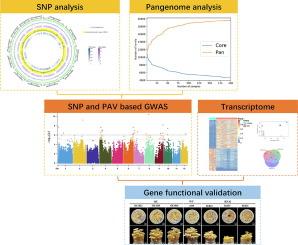当前位置:
X-MOL 学术
›
J. Adv. Res.
›
论文详情
Our official English website, www.x-mol.net, welcomes your
feedback! (Note: you will need to create a separate account there.)
Pan-genome analysis reveals genomic variations during enoki mushroom domestication, with emphasis on genetic signatures of cap color and stipe length
Journal of Advanced Research ( IF 11.4 ) Pub Date : 2024-11-05 , DOI: 10.1016/j.jare.2024.11.005 Fei Liu, Xin-Bing Ma, Bei Han, Bo Wang, Jian-Ping Xu, Bin Cao, Zhi-Lin Ling, Mao-Qiang He, Xin-Yu Zhu, Rui-Lin Zhao
中文翻译:

泛基因组分析揭示了金针菇驯化过程中的基因组变异,重点是菌盖颜色和菌柄长度的遗传特征
食用蘑菇(包括 Flammulina filiformis)的驯化为了解人工选择驱动的遗传变化提供了有价值的见解。了解这些变化对于揭示驯化蘑菇基因组进化背后的机制至关重要。
本研究旨在研究丝状镰刀菌的种群结构、遗传多样性和驯化相关的基因组变化。通过比较 199 种野生和培养菌株的基因组序列,我们旨在阐明驯化对 F. filiformis 的影响。
我们对 199 种菌株进行了从头基因组组装和基于基因的泛基因组分析,其中包括野生和培养菌株。我们还使用存在-不存在变异 (PAV) 和 SNP 数据进行了全基因组关联研究 (GWAS),并结合 RNA 测序,以鉴定与驯化性状相关的基因,例如菌盖颜色和茎长。通过基因转化实验实现基因功能确认。
我们的分析将这些菌株分为四个不同的种群,这些种群与人工选择的不同强度相关。与野生种群相比,三个培养种群表现出较小的基因组大小、较少的基因、较低的遗传变异、较低的基因表达多样性和较低的杂合性。分析揭示了在驯化过程中与 β-内酰胺类抗生素分解代谢过程和特异性 MAPK 通路基因相关的基因丢失,使驯化菌株更容易患病。鉴定出 4 个与菌盖颜色和菌柄长度密切相关的基因,但遗传转化实验证实了仅通过基于 PAV 的 GWAS 鉴定的 2 个基因 (FfB 和 FfD) 的功能相关性。
这项研究揭示了栽培和野生金针菇种群之间的显著基因组变异,包括驯化过程中病原体抗性基因的丢失。我们还鉴定了与菌盖颜色和菌柄长度相关的关键基因,首次证明了 PAV 变异在蘑菇驯化中的重要作用。这些见解为未来的蘑菇育种和进化研究奠定了基础。
更新日期:2024-11-05
Journal of Advanced Research ( IF 11.4 ) Pub Date : 2024-11-05 , DOI: 10.1016/j.jare.2024.11.005 Fei Liu, Xin-Bing Ma, Bei Han, Bo Wang, Jian-Ping Xu, Bin Cao, Zhi-Lin Ling, Mao-Qiang He, Xin-Yu Zhu, Rui-Lin Zhao

|
Introduction
The domestication of edible mushrooms, including Flammulina filiformis, offers valuable insights into the genetic changes driven by artificial selection. Understanding these changes is crucial for uncovering the mechanisms behind genome evolution in domesticated mushrooms.Objectives
This study aims to investigate the population structure, genetic diversity, and domestication-related genomic changes in F. filiformis. By comparing the genome sequences of 199 wild and cultivated strains, we aim to elucidate the impact of domestication on F. filiformis.Methods
We performed de novo genome assembly and gene-based pan-genome analysis on the 199 strains, which included both wild and cultivated strains. We also conducted genome-wide association studies (GWAS) using presence-absence variation (PAV) and SNP data, combined with RNA sequencing, to identify genes associated with domestication traits, such as cap color and stalk length. Gene functional confirmation was achieved through genetic transformation experiments.Results
Our analysis grouped the strains into four distinct populations, which correlated with varying intensities of artificial selection. The three cultivated populations exhibited smaller genome sizes, fewer genes, lower genetic variation, reduced gene expression diversity, and lower heterozygosity compared to the wild population. The analysis revealed the loss of genes related to the beta-lactam antibiotic catabolic process and specific MAPK pathway genes during domestication, rendering domesticated strains more susceptible to diseases. Four genes closely associated with cap color and stipe length were identified, but genetic transformation experiments confirmed the functional relevance of only two (FfB and FfD) identified through PAV-based GWAS.Conclusion
This study uncovered significant genomic variations between cultivated and wild Flammulina filiformis populations, including the loss of pathogen resistance genes during domestication. We also identified key genes linked to cap color and stipe length, demonstrating for the first time the important role of PAV variation in mushroom domestication. These insights provide a foundation for future mushroom breeding and evolutionary research.中文翻译:

泛基因组分析揭示了金针菇驯化过程中的基因组变异,重点是菌盖颜色和菌柄长度的遗传特征
介绍
食用蘑菇(包括 Flammulina filiformis)的驯化为了解人工选择驱动的遗传变化提供了有价值的见解。了解这些变化对于揭示驯化蘑菇基因组进化背后的机制至关重要。
目标
本研究旨在研究丝状镰刀菌的种群结构、遗传多样性和驯化相关的基因组变化。通过比较 199 种野生和培养菌株的基因组序列,我们旨在阐明驯化对 F. filiformis 的影响。
方法
我们对 199 种菌株进行了从头基因组组装和基于基因的泛基因组分析,其中包括野生和培养菌株。我们还使用存在-不存在变异 (PAV) 和 SNP 数据进行了全基因组关联研究 (GWAS),并结合 RNA 测序,以鉴定与驯化性状相关的基因,例如菌盖颜色和茎长。通过基因转化实验实现基因功能确认。
结果
我们的分析将这些菌株分为四个不同的种群,这些种群与人工选择的不同强度相关。与野生种群相比,三个培养种群表现出较小的基因组大小、较少的基因、较低的遗传变异、较低的基因表达多样性和较低的杂合性。分析揭示了在驯化过程中与 β-内酰胺类抗生素分解代谢过程和特异性 MAPK 通路基因相关的基因丢失,使驯化菌株更容易患病。鉴定出 4 个与菌盖颜色和菌柄长度密切相关的基因,但遗传转化实验证实了仅通过基于 PAV 的 GWAS 鉴定的 2 个基因 (FfB 和 FfD) 的功能相关性。
结论
这项研究揭示了栽培和野生金针菇种群之间的显著基因组变异,包括驯化过程中病原体抗性基因的丢失。我们还鉴定了与菌盖颜色和菌柄长度相关的关键基因,首次证明了 PAV 变异在蘑菇驯化中的重要作用。这些见解为未来的蘑菇育种和进化研究奠定了基础。


















































 京公网安备 11010802027423号
京公网安备 11010802027423号